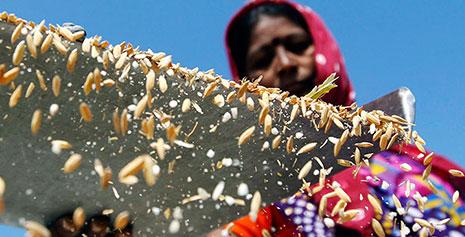Next Generation 2019 – A Sea Change for Seafood: Agrifood Tech as the Result of Research, Innovation, and Collaboration | Chicago Council on Global Affairs

The Chicago Council on Global Affairs is pleased to present the 2019 Next Generation Delegates blog series. This year’s Delegation was comprised of 20 outstanding students from universities across the United States and around the world studying agriculture, food, and related disciplines. We were thrilled to feature these emerging leaders at the Global Food Security Symposium 2019, and look forward to sharing the exciting work of this extraordinary group.
This March, the Chicago Council on Global Affairs brought thought leaders around from around the world to Washington, DC, to discuss the state of global food security. We know as the global population continues to increase, it’s estimated we will need to double our food supply by 2050 to meet growing demand. We heard that agriculture accounts for the largest percentage of water usage of any sector and will remain the greatest draw of freshwater resources for the anticipated future. We agreed water is a vital resource which is becoming increasingly scarce.
So, what is the global collective doing to encourage sustainable water management, an essential element to ensuring a secure food future? Hearing each Next Generation Delegate’s unique perspective was the greatest opportunity the symposium offered. This diverse collection of voices brought more than insight and ideas; it highlighted the great strides our future leaders, entrepreneurs, lawyers, scientists, and farmers are already making towards meeting global water challenges.
As a Delegate, I posit that recent progress, in sustainable aquaculture (farming of aquatic plants and animals), demonstrates that a paradigm shift towards increased food security and water stewardship is possible. In line with The Chicago Council’s task force report, which cites an imperative need for “improving crop and livestock productivity per unit of water and land through agricultural research, development, technology, extension, and financing,” sustainable aquaculture may offer a model which others in the AgriFood sector could follow.
As one of the fastest growing food production sectors, aquaculture has become an indispensable element of food security. Currently, over one billion people depend on fish as their primary protein source, and more than three billion rely on fish for at least 20 percent of their protein intake. The pressures on wild fisheries have continually intensified since the 1960s, fueled by population growth and diet preferences which include increased fish consumption as part of a healthy lifestyle. Commercial overfishing has led to stagnant wild harvest rates and a need for alternatives. Today, aquaculture provides over half of all seafood consumed globally, a number that’s expected to rise with continued demand.
Conventional aquaculture practices, which utilize large quantities of water and discharge dilute nutrient pollution, cannot sustainably expand production. To fill the gap, a growing movement of sustainable freshwater aquaculture radically reimagines fish cultivation. The industry aims, through collaborative international academic research and engineering developments, to demonstrate that increased production, with less available resources and minimized environmental impacts, is possible.
Recirculating aquaculture systems (RAS), an intensive land-based fish farming method, doesn’t take the notion of sustainability lightly. Through advances in design technology, RAS allow up to an astonishing 99 percent water reuse efficiency. The continuous clean water availability enables previously unheard-of stocking densities, rivaling the production rates of other land-based farming methods, particularly given the significant water usage reductions. The RAS approach deviates from traditional outdoor fish production methods; instead, fish are grown indoors under tightly controlled biosecure environments (i.e., pristine conditions), resulting in a highly desired antibiotic-free product. Furthermore, waste effluents produced in these systems are easily captured and can be made available for fertilizer, fueling additional agriculture growth, and thus closing the sustainable production loop. These proven commitments to sustainability have earned RAS-raised salmon a “best choice” (green) rating by the Monterey Bay Aquarium Seafood Watch.
The reduced water requirements also allow for facility construction independent of large water sources, thereby greatly increasing flexibility for site selection. By strategically constructing facilities near urban markets (even away from coastlines), we can increase local accessibility to fresh, healthy, and sustainable seafood. In recent years the industry has seen a substantial expansion in the United States, with the world’s largest aquaponic farm, Superior Fresh (made possible by RAS salmon), opening in 2017 in Wisconsin. Norwegian-based Atlantic Sapphire also has a new facility under construction in Florida that is set to open in 2020; once fully operational they intend to capture 10% of the stateside salmon market. Similarly, Nordic Aquafarms also has plans for a facility in Maine which aspires to be one of the largest RAS salmon farms in the world.
With collaboration, the RAS movement is gaining traction, despite hurdles which have previously discouraged implementation. Governments, NGOs, non-profits, industry, and individuals have pulled together to fund research to improve designs, reduce capital and operational expenditures, and increase productivity. International workshops and conferences offer extension support and networking opportunities. Financing RAS operations remains a priority, and investors have been encouraged to engage directly with the sustainable aquaculture community. Disruption of an established industry will not be without challenges, but a complete sea change against the tide of current trends is possible.
As a Research Associate for The Conservation Fund’s Freshwater Institute (West Virginia, USA), I work for one of the international leaders in the advancement of the technology, design, and implementation of RAS. Together we work to shape environmentally responsible water management solutions.
